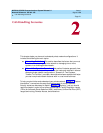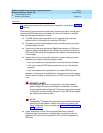
MERLIN LEGEND Communications System Release 6.1
Network Reference
555-661-150
Issue 1
August 1998
Call-Handling Scenarios
Page 2-8Networking Guidelines
2
The following general rules make ARS routing both simpler and safer:
■ Common Access Code. For proper handling of calls across the private
network, all systems in the private network should use the same ARS
access code. Using a common ARS code across the private network
provides ease of use for users travelling between sites, and also ensures
completion of Dial 0 and 101xxxx equal access code calls.
■ Security.
— The ARS non-local access code
must not
be programmed into the non-
local dial plan, as mentioned earlier in this section.
— It is the responsibility of the switch where ARS calls originate to prevent
toll fraud.
■ Co-located Network Switches. When two or more systems are located at
the same street address, and one of the systems does not have PSTN
trunks connected, some tandem trunks from that system must be assigned
to the default pool and all ARS tables (including Table 17, 18, Dial 0, and
Special Numbers tables) must prepend the ARS code for the co-located
private network system. This will assure that 911 calls will be routed
properly and that the correct calling address will be identified.
Additional information about ARS security is included in Chapter 4, “Security.”
Remote Access 2
When non-local users access ARS to dial out over PSTN facilities connected to
your local system or to another system connected to yours, your system uses a
special form of the Remote Access feature to accommodate these calls. Because
calls are routed from one system to one or more other systems, the remote
access settings for this purpose are distinct from the Remote Access feature used
by individuals who enter a barrier code in order to reach an extension or place an
outgoing call on the system.
The remaining topics provide additional details about programming remote
access in private networks.
Programming Remote
Access over Tandem Trunks 2
Non-local users who access your PSTN trunks via ARS and private network
trunks do not dial a remote-access barrier code. For security purposes, the
system applies the default class-of-restriction (COR) calling restrictions that you
assign to all tie (T1-emulated voice or data, or analog) or non-tie (PRI) trunks,
ignoring the barrier code requirement setting. If remote users connect to your
system via tandem PRI facilities, the non-tie restrictions apply; otherwise, the tie
restrictions apply. You can program both types of COR if needed, using the
following system programming procedure (refer to
System Programming
guide for
detailed instructions).


















